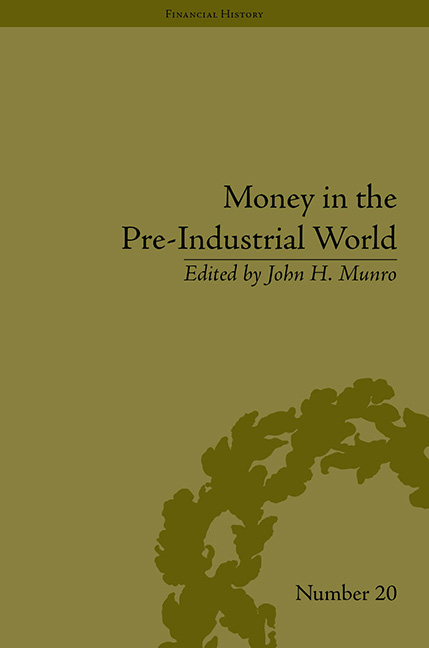Book contents
- Frontmatter
- CONTENTS
- List of Figures and Tables
- List of Contributors
- Introduction
- 1 The Technology and Economics of Coinage Debasements in Medieval and Early Modern Europe: with Special Reference to the Low Countries and England
- 2 From Aurelian to Diocletian: Financing Imperial Recovery by Coinage Debasements and Fiduciary Currencies
- 3 The Making of a Gold Standard: The Ducat and its Offspring, 1284–2001
- 4 Debasement of the Coinage and its Effects on Exchange Rates and the Economy: in England in the 1540s, and in the Burgundian-Habsburg Netherlands in the 1480s
- 5 The Amsterdam Wisselbank's Innovations in the Monetary Sphere: The Role of ‘Bank Money’
- 6 Silver in England 1600–1800: Coinage Outputs and Bullion Exports from the Records of the London Tower Mint and the London Company of Goldsmiths
- 7 The Burdens of Tradition: Debasements, Coinage Circulation and Mercantilist Public Policy Debates in Seventeenth-Century Aragon
- 8 Money or Export Commodity for Asia? American Silver in the Markets of Mexico, Castile and Amsterdam from the Sixteenth to the Eighteenth Century
- 9 Cacao Beans in Colonial México: Small Change in a Global Economy
- 10 Precious Metals, Debasements and Cowrie Shells in the Medieval Indian Monetary Systems, c. 1200–1575
- Notes
- Index
4 - Debasement of the Coinage and its Effects on Exchange Rates and the Economy: in England in the 1540s, and in the Burgundian-Habsburg Netherlands in the 1480s
- Frontmatter
- CONTENTS
- List of Figures and Tables
- List of Contributors
- Introduction
- 1 The Technology and Economics of Coinage Debasements in Medieval and Early Modern Europe: with Special Reference to the Low Countries and England
- 2 From Aurelian to Diocletian: Financing Imperial Recovery by Coinage Debasements and Fiduciary Currencies
- 3 The Making of a Gold Standard: The Ducat and its Offspring, 1284–2001
- 4 Debasement of the Coinage and its Effects on Exchange Rates and the Economy: in England in the 1540s, and in the Burgundian-Habsburg Netherlands in the 1480s
- 5 The Amsterdam Wisselbank's Innovations in the Monetary Sphere: The Role of ‘Bank Money’
- 6 Silver in England 1600–1800: Coinage Outputs and Bullion Exports from the Records of the London Tower Mint and the London Company of Goldsmiths
- 7 The Burdens of Tradition: Debasements, Coinage Circulation and Mercantilist Public Policy Debates in Seventeenth-Century Aragon
- 8 Money or Export Commodity for Asia? American Silver in the Markets of Mexico, Castile and Amsterdam from the Sixteenth to the Eighteenth Century
- 9 Cacao Beans in Colonial México: Small Change in a Global Economy
- 10 Precious Metals, Debasements and Cowrie Shells in the Medieval Indian Monetary Systems, c. 1200–1575
- Notes
- Index
Summary
I: England in the 1540s
In the introduction to my Handbook of Medieval Exchange, I presented the hypothesis that exchange rates by and large oscillated about the intrinsic metal contents of the coins underlying the moneys of account concerned. I still believe this to be true in normal times, when the intrinsic metal content of a coinage was basically equal to the price of the metal in it, minus the costs of coining, and with negligible profit or loss to the ruler. However, my hypothesis does not work when currencies were debased, for example in France at the end of Charles VII's reign, between 1417 and 1422. Numismatists, concerned with the coins themselves, have naturally concentrated on their weight and fineness. For normal times this is also what economic historians need to know. However, it is now apparent that in abnormal times, in debasement conditions, economic historians should be more interested in the prices offered by the mints for silver than with what the mints did with it afterwards. In periods of debasement there was quite frequently a deliberate official policy of secrecy to prevent the public from knowing the extent of debasement. If the public did not know how far the coin was being debased, they did know how much the mint was prepared to pay for silver, and adjusted their expectations to this, on the false assumption, that, as in normal times, debasement was in proportion to the rise in the price offered for silver.
In the Dauphin's parts of France a sequence of debasements meant that 46 times the value of coin was actually made from the marc of silver in 1422 than had been made in 1416. The public did not know this. What they did know was that at the same time the sum paid for the marc of silver had increased twelve-fold. If they thought that debasement was of this order they were hopelessly wrong.
- Type
- Chapter
- Information
- Money in the Pre-Industrial WorldBullion, Debasements and Coin Substitutes, pp. 63 - 86Publisher: Pickering & ChattoFirst published in: 2014



